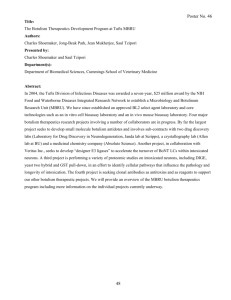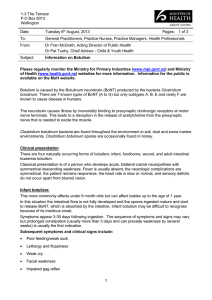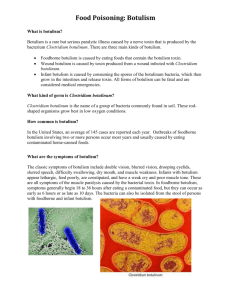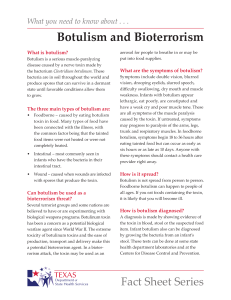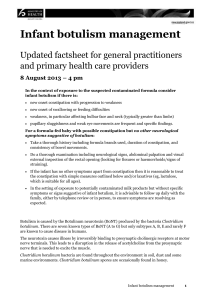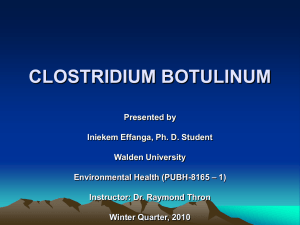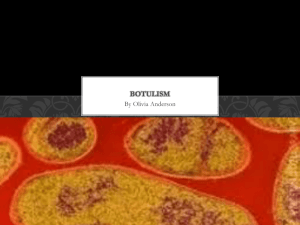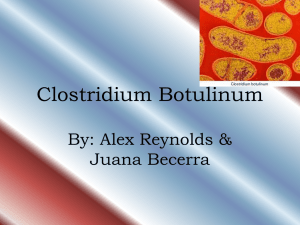Infant Botulism Management
advertisement
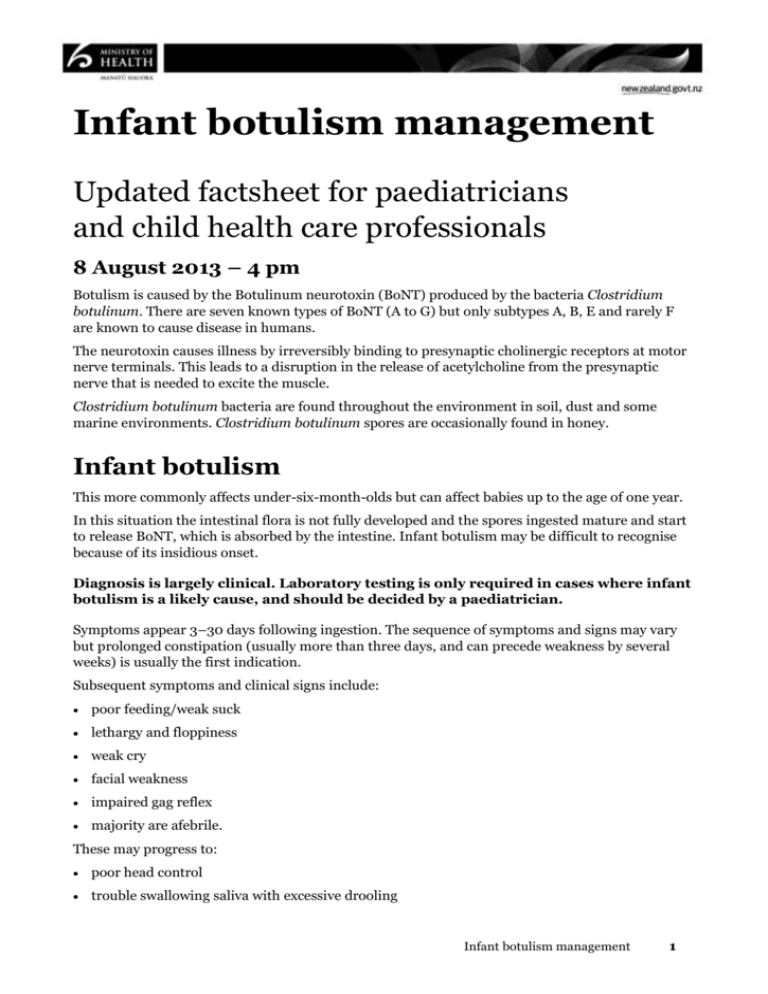
Infant botulism management Updated factsheet for paediatricians and child health care professionals 8 August 2013 – 4 pm Botulism is caused by the Botulinum neurotoxin (BoNT) produced by the bacteria Clostridium botulinum. There are seven known types of BoNT (A to G) but only subtypes A, B, E and rarely F are known to cause disease in humans. The neurotoxin causes illness by irreversibly binding to presynaptic cholinergic receptors at motor nerve terminals. This leads to a disruption in the release of acetylcholine from the presynaptic nerve that is needed to excite the muscle. Clostridium botulinum bacteria are found throughout the environment in soil, dust and some marine environments. Clostridium botulinum spores are occasionally found in honey. Infant botulism This more commonly affects under-six-month-olds but can affect babies up to the age of one year. In this situation the intestinal flora is not fully developed and the spores ingested mature and start to release BoNT, which is absorbed by the intestine. Infant botulism may be difficult to recognise because of its insidious onset. Diagnosis is largely clinical. Laboratory testing is only required in cases where infant botulism is a likely cause, and should be decided by a paediatrician. Symptoms appear 3–30 days following ingestion. The sequence of symptoms and signs may vary but prolonged constipation (usually more than three days, and can precede weakness by several weeks) is usually the first indication. Subsequent symptoms and clinical signs include: poor feeding/weak suck lethargy and floppiness weak cry facial weakness impaired gag reflex majority are afebrile. These may progress to: poor head control trouble swallowing saliva with excessive drooling Infant botulism management 1 generalised muscle weakness loss of ocular motility, ptosis and sluggish pupils. Difficulty breathing and respiratory failure are late signs and can quickly lead to respiratory arrest. The condition progresses for 1–2 weeks, and then stabilises for 2–3 weeks before recovery starts. Typically these children do not have fever. The symptoms are those of acute flaccid paralysis and have a differential diagnosis of infantile poliomyelitis, sepsis, meningitis, encephalitis, Guillain-Barre syndrome, some metabolic disorders, poisoning from a range of toxins, and some other neuromuscular disorders. In the context of exposure to the suspected contaminated formula consider infant botulism if there is: new onset constipation with progression to weakness new onset of swallowing or feeding difficulties weakness in particular affecting bulbar face and neck (typically greater than limbs) pupillary sluggishness and weak eye movements are frequent and specific findings. Assessment and investigations Take a full history including suspicious food, specific formula details and other people potentially infected. A detailed neurological examination looking for subtle signs of bulbar palsy should be undertaken. Consider alternate diagnosis for acute flaccid paralysis. If the differential diagnosis suggests bacterial sepsis then be aware that aminoglycosides can worsen the effects of the neurotoxin. If there is evidence of respiratory distress emergency management and respiratory support should not be delayed. Other causes need to be excluded including examination for sepsis, meningoencephalitis, electrolyte abnormalities, spinal lesions and Guillian-Barre syndrome. All cases must be reported to the local Medical Officer of Health – suspected botulism can be notified under the Health Act 1956 as acute flaccid paralysis (suspect polio) or acute gastroenteritis. All cases should also be reported immediately to the Paediatric Surveillance Unit in Dunedin (ie, do not wait for acute flaccid paralysis monthly report card). If the case has features consistent with infant botulism then clinical samples needed are: Stool, enema or gastric aspirates specimens are the best for culture of Clostridium botulinum. Enema likely to be required in view of constipation. Samples of suspected cases of botulism are to be sent to NCBID Wallaceville, ESR Wellington (attention Muriel Dufour) via local laboratory. It is essential that a contact phone number for the responsible paediatrician and/or unit is appended to the request form so that the results can be provided promptly back to the referrer. ESR will arrange for the sample to be transferred to the Microbiological Diagnostic Unit (MDU) at the University of Melbourne for testing. A microbiological result will be available within 8–10 days of the sample being taken. The Melbourne MDU will contact the referring paediatrician by telephone with the result and also inform ESR Wallaceville. Infant botulism management 2 Treatment Botulism can be treated with prompt assessment and care. The majority fully recover. All suspected cases of botulism should be discussed with paediatric subspecialist services (infectious diseases and/or neurology). Assessment and decision will be made regarding the appropriate use of the botulism antitoxin ‘Botulism Immune Globulin Intravenous’ (BIG-IV). Baby BIG® for infants needs urgent application to obtain from overseas. Starship Children’s Hospital has information about the necessary steps to obtain BIG-IV. Initial treatment is based on the clinical picture, and if a diagnosis of infant botulism is clinically suspected, then a course of immunoglobulin can be commenced before microbiological confirmation is received. An affected child should be considered for early transfer to Starship Children’s Hospital. The neurotoxin effects wear off over time but the affected infant is likely to require intensive care and ventilation during this process, even if BIG-IV is given. Isolation Standard precautions only are required. Notification All cases must be reported to the local Medical Officer of Health – suspected botulism can be notified under the Health Act 1956 as acute flaccid paralysis (suspect polio) or acute gastroenteritis. All cases should also be reported immediately to the Paediatric Surveillance Unit in Dunedin (ie, do not wait for acute flaccid paralysis monthly report card). Contact details for the PSU are: Tel Fax Email 03 474 7825 03 474 7817 nzpsu@otago.ac.nz For more information see: http://www.foodsafety.govt.nz/elibrary/industry/Clostridium_BotulinumNeurotoxins_Produced.pdf http://www.health.alberta.ca/documents/Guidelines-Botulism-2013.pdf http://emedicine.medscape.com/article/961833-overview http://www.cdc.gov/nczved/divisions/dfbmd/diseases/botulism HP5670 Infant botulism management 3
